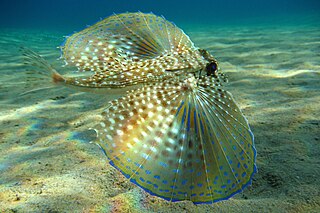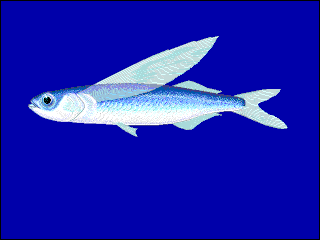
The red lionfish is a venomous coral reef fish in the family Scorpaenidae, order Scorpaeniformes. It is mainly native to the Indo-Pacific region, but has become an invasive species in the Caribbean Sea, as well as along the East Coast of the United States and East Mediterranean and also found in Brazil at Fernando de Noronha.

The Mesoamerican Barrier Reef System (MBRS), also popularly known as the Great Mayan Reef or Great Maya Reef, is a marine region that stretches over 1,126 kilometres (700 mi) along the coasts of four countries – Mexico, Belize, Guatemala, and Honduras – from Isla Contoy at the northern tip of the Yucatán Peninsula south to Belize, Guatemala and the Bay Islands of Honduras. The reef system includes various protected areas and parks including the Belize Barrier Reef, Arrecifes de Cozumel National Park, Hol Chan Marine Reserve (Belize), Sian Ka'an biosphere reserve, and the Cayos Cochinos Marine Park. Belize's coastline, including the Belize Barrier Reef, is home to approximately 30% of the Mesoamerican Barrier Reef System.

Pterois miles, the devil firefish or common lionfish, is a species of ray-finned fish native to the western Indo-Pacific region. It is frequently confused with its close relative, the red lionfish. The scientific name is from Greek pteron, meaning "wing", and Latin miles, meaning "soldier".

The longtail seamoth is a species of fish in the family Pegasidae. It is found around the coasts of Australia, Bahrain, China, India, Indonesia, Malaysia, Mozambique, Myanmar, the Philippines, Saudi Arabia, Singapore, Taiwan, Tanzania, and Thailand. This fish is used in Chinese medicine and in the aquarium trade.

The flying gurnard, also known as the helmet gurnard, is a bottom-dwelling fish of tropical to warm temperate waters on both sides of the Atlantic. On the American side, it is found as far north as Massachusetts and as far south as Argentina, including the Caribbean and Gulf of Mexico. On the European and African side, it ranges from the English Channel to Angola, including the Mediterranean. This is the only species in the monotypic genus Dactylopterus. Similar and related species from the genus Dactyloptena are found in the Indian and Pacific Oceans.

Tetraplatia is a genus of hydrozoans in the order Narcomedusae. It is the sole genus in the monotypic family Tetraplatidae.

Pterois is a genus of venomous marine fish, commonly known as lionfish, native to the Indo-Pacific. It is characterized by conspicuous warning coloration with red or black bands, and ostentatious dorsal fins tipped with venomous spines. Pterois radiata, Pterois volitans, and Pterois miles are the most commonly studied species in the genus. Pterois species are popular aquarium fish. P. volitans and P. miles are recent and significant invasive species in the west Atlantic, Caribbean Sea and Mediterranean Sea.

Pogonocherini is a tribe of longhorn beetles of the subfamily Lamiinae.
Poliaenus is a genus of longhorn beetles of the subfamily Lamiinae, containing the following species:
Stenoma volitans is a moth of the family Depressariidae. It is found in Peru.
Poliaenus abietis is a species of beetle in the family Cerambycidae. It was described by Tyson in 1968. It is known from the United States.
Poliaenus batesi is a species of beetle in the family Cerambycidae. It was described by Linsley in 1933. It is known from Guatemala.
Poliaenus californicus is a species of beetle in the family Cerambycidae. It was described by Schaeffer in 1908. It is known from the United States.
Poliaenus concolor is a species of beetle in the family Cerambycidae. It was described by Schaeffer in 1909. It is known from Baja California.
Poliaenus hesperus is a species of beetle in the family Cerambycidae. It was described by Chemsak and Linsley in 1988. It is known from Mexico.
Poliaenus negundo is a species of beetle in the family Cerambycidae. It was described by Schaeffer in 1905. It is known from Mexico and the United States.
Poliaenus nuevoleonis is a species of beetle in the family Cerambycidae. It was described by Chemsak and Linsley in 1975.
Poliaenus obscurus is a species of beetle in the family Cerambycidae. It was described by Fall in 1910.
Poliaenus oregonus is a species of beetle in the family Cerambycidae. It was described by John Lawrence LeConte in 1861. It is known from North America.

Exocoetus volitans, commonly known as the tropical two-wing flyingfish or blue flyingfish, is a species of ray-finned fish native to tropical and subtropical seas. It can glide above the surface of the sea to escape predators.








